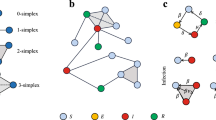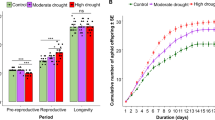Abstract
A descriptive epizootiological model is proposed and parameterized to predict the dynamics of the host-pathogen system “Cereal aphid — entomophthoralean fungusErynia neoaphidis”. The model partitions the host population into distinct classes corresponding to fungal development stages. The dynamics of each class density are described by a set of non-linear ordinary differential equations with the reciprocal of estimated parameter giving average transit or developmental times. The model is compared to the biological data. The experiment was performed under controlled conditions of 20°C and RH >95% using the cereal aphidSitobion avenae as the host. The stability of the model was examined and indicated periodic oscillations, i.e. epizootic intervals separated by longer enzootic periods. In addition, Lotka-Volterra mass action assumption for transmission rate was tested using the data.
Résumé
Un modèle déterministe est proposé pour prédire la dynamique d’un système hôte-pathogène “Pucerons des céréales et l’EntomophthoraleErynia neoaphidis”. Le modèle divise la population hôte en quatre classes distinctes correspondant aux différents stades du cycle infectieux du champignon. La dynamique temporelle des densités de chaque classe est décrite par un ensemble de quatre équations différentielles ordinaires non-linéaires dont l’inverse des paramètres estimés fournissent des durées moyennes de développement ou de transit. Le modèle est confronté à des données biologiques. L’expérience est réalisée en conditions contrôlées (20°C et HR >95%) et utiliseSitobion avenae comme hôte. La stabilité du modèle a été étudiée et montre des oscillations périodiques, c’est-à-dire des intervalles épizootiques séparées par des périodes enzootiques plus longues. De plus, l’hypothèse de bilinéarité du taux de transmission (ou la loi “d’action de masse” de Lotka-Volterra) a été testée en utilisant les données expérimentales.
Similar content being viewed by others
References
Anderson, R. M. &May, R. M. — 1981. The population dynamics of microparasites and their invertebrate hosts. —Philos. Trans. R. Soc. London Ser. B. 291, 2451–524.
Brobyn, P. J. &Wilding, N. — 1977. Invasive and developmental processes ofEntomophthora species infecting aphids. —Trans. Br. mycol. Soc., 69, 349–366.
Brown, G. C. — 1987. Modeling.In “Epizootiology of Insect Diseases”.J. R. Fuxa &Y. Tanada Eds.Wiley, New-York.
Brown, G. C. &Nordin, G. L. — 1982. An epizootic model of an insect-fungal pathogen system.Bull. Math. Biol., 44, 731–739.
Brown, G. C. &Hasibuan, R. — 1995. Conidial discharge and transmission efficiency ofNeozygites floridana, an entomopathogenic fungus infecting two-spotted spider mites under laboratory conditions. —J. Invertebr. Pathol., 65, 10–16.
Butt, T. M., Beckett, A. &Wilding, N. — 1990. A histological study of the invasive and developmental processes of the aphid pathogenErynia neophidis (Zygomycotina: Entomophthorales) in the pea aphidAcyrthosiphon pisum. —Can. J. Bot., 68, 2153–2163.
Capasso, V. — 1993. Mathematical Structures of Epidemic Systems. Lectures Notes In Biomathematics. Vol. 97. —Springer-Verlag, Heidelberg.
Capasso, V. &Serio, G. — 1978. A generalization of the Kermack-McKendrick deterministic epidemic model. —Math. Biosciences, 42, 43–61.
Courtois, P., Latteur, G. &Oger, R. — 1983. Méthode rapide d’estimation de la quantité de conidies primaires d’Erynia neoaphidis (Rem. & Henn.) (Zygomycètes: Entomophthorales) produites par des momies d’Acyrthosiphon pisum (Hom.:Aphididae). —Parasitica, 39, 173–182.
Dedryver, C. A. — 1978. Rôle de l7rshumidité relative sur le développement du champignon parasiteEntomophthora aphidis Hoffman, dans les populations de l’aphideSitobion avenae F., en 1976 dans l’ouest de la France. —C. R. Acad. Sci. Paris 286 (série D), 1723–1726.
Dedryver, C. A. — 1979. Déclenchement en serre d’une épizootie àEntomophthora fresenii surAphis fabae par introduction d’inoculum et régulation de l’humidité relative. —BioControl, 24, 443–453.
Dedryver, C. A. — 1981. Biologie des pucerons des céréales dans l’ouest de la France. II. Répartition spatio-temporelle et action limitative de trois espèces d’Entomophthoraceae. —BioControl, 26, 381–393.
Dedryver, C. A. — 1982. Field pathogenesis of three species of Entomophthorales of cereal aphids in Western France. In: “Aphid Antagonists” (R. Cavalloro, ed.), pp. 11–20.A. A. Balkema, Rotterdam.
Dedryver, C. A. — 1987. Biologie, Ecologie et Dynamique de populations de pucerons des céréales en climat océanique. Thèse de doctorat d’état en sciences naturelles, Université de Paris XI, Centre d’Orsay. 204 pp.
Draper, N. R. &Smith, H. — 1981. Applied regression analysis. Second edition,Wiley, New-York.
Fuxa, J. R. &Tanada, Y. — 1987. Epidemiological concepts applied to insect epizootiology. In “Epizootiology of insect diseases”.J. R. Fuxa &Y. Tanada Eds pp. 3–21.Wiley, New-York.
Gutierrez, A. P., Hagen, K. S., Ellis, C. K. — 1980. Evaluating the impact of natural enemies: a multitrophic perspective, pp. 81–109. In: Critical issues in Biological Control, (M. Mackauer, L. E. Ehler &Roland J., Eds). —Intercept, Andover, Hants., UK.
Gutierrez, A. P. — 1996. Applied population ecology, a supply-demand approach.Wiley, New-York.
Hajek, A. E. &St Leger, R. J. — 1994. Interactions between fungal pathogens and insects hosts. —Annu. Rev. Entomol., 39, 293–322.
Hethcote, H. W. — 1976. Qualitative analyses of communicable disease models. —Math. Biosciences, 28, 335–356.
Kermack, W. D. &McKendrick, A. G. — 1927. A contribution to the mathematical theory of epidemics. —J. R. Statist. Soc. Serie A, 115, 700–721.
Lotka, A. J. — 1925. Elements of physical biology. —Williams & Wilkins. Baltimore.
Maple V. — 1991. Maple V Library Reference Manual. Bruce Charet al., 1st ed., 698 pp. —Springer-Verlag, Heidelberg.
Millstein, J. A., Brown, G. C. &Nordin, L. — 1982. Microclimatic humidity influence on conidial discharge inErynia sp. (Entomophthorales:Entomophthoraceae), an entomopathogenic fungus of the alfalfa weevil (Coleoptera:Curculionidae). —Environ. Entomol., 11, 1166–1169.
Milner, R. J. — 1981. Patterns of primary spore discharge ofEntomophthora spp from the blue green aphidAcyrthosiphon kondoi. —J. Invertebr. Pathol., 38, 419–425.
Milner, R. J. — 1982. On the occurence of pea aphids,Acyrthosiphon pisum, resistant to isolates of the fungal pathogenErynia neoaphidis. —Entomol. exp. appl., 32, 23–27.
Milner, R. J., Holdom, D. G. &Glare, T. R. — 1984. Diurnal patterns of mortality in aphids infected by Entomophthoralean fungi. —Entomol. exp. appl., 36, 37–42.
Missonnier, J., Robert, Y. &Thoizon, G. — 1970. Circonstances épidémiologiques semblant favoriser le développement des mycoses à Entomophthorales chez trois aphides,Aphis fabae Scop.,Capitophorus horni Börner etMyzus persicae Sulz. —BioControl, 15, 169–199.
Oger, L. &Latteur, G. — 1985. Description et précision d’une nouvelle méthode d’estimation de la virulence d’une Entomophthorale de pucerons. —Parasitica, 41, 135–150.
Onstad, D. W. &Carruthers, R. I. — 1990. Epizootiological models of insect diseases. —Annu. Rev. Entomol., 35, 399–419.
Onstad, D. W. — 1993. Thresholds and density dependence: the roles of pathogen and insect densities in disease dynamics (Commentary). —Biol. Control, 3, 353–356.
Papierok, B. &Wilding, N. — 1979. Mise en évidence d’une différence de sensibilité entre deux clones du puceron du poisAcyrthosiphon pisum Harr. (Homoptères:Aphididae), exposé à 2 souches du champignon PhycomycèteEntomophthora obscura Hall & Dunn. —C. R. Acad. Sci. Paris Ser. D., 288, 93–95.
Papierok, B. &Wilding, N. — 1981. Etude du comportement de plusieurs souches deConidiobolus obscurus (Zygomycètes: Entomophthoraceae) vis-à-vis des puceronsAcyrthosiphon pisum etSitobion avenae (Hom.:Aphididae). —BioControl, 26, 241–249.
Pell, J. K., Wilding, N., Player, A. L. &Clark, S. J. — 1993. Selection of an isolate ofZoophthora radicans (Zygomycetes: Entomophthorales) for biocontrol of the diamondback mothPlutella xylostella (Lepidoptera: Yponomeutidae). —J. Invertebr. Pathol., 61, 75–80.
Pierre, J. S. &Dedryver, C. A. — 1984. Un modèle de régression multiple appliqué à la prévision des pullulations d’un puceron des céréales,Sitobion avenae F., sur blé d’hiver.Acta Oecologica/Oecol. Appl. 5, 153–172.
Plantegenest, M. — 1995. Modélisation de la dynamique de population du puceron des épis (Sitobion avenae F.) sur blé d’hiver au printemps et en été — Application au raisonnement de la lutte chimique. Thèse de doctorat de l’Université François-Rabelais, Tours. 180 pp..
Remaudière, G. &Hennebert, G. L. — 1980. Révision systématique deEntomophthora aphidis Hoffm. in Fres. Description de deux nouveaux pathogènes d’aphides. —Mycotaxon, 11, 269–321.
Remaudière, G., Latgé, J. P. &Michel, M. F. — 1981. Ecologie comparée des Entomophthoracées pathogènes de pucerons en France littorale et continentale. —BioControl, 26, 157–178.
Schmitz, V., Dedryver, C. A. &Pierre, J. S. — 1993. Influence of anErynia neoaphidis infection on the relative rate of increase of the cereal aphidSitobion avenae. —J. Invertebr. Pathol., 61, 62–68.
Volterra, V. — 1926. Variazione fluttuazioni del numero d’individui in specie animali conviventi.Mem. Acad. Lincei. 2, 31–113. (Variations and fluctuations of a number of individuals in animal species living together. Translation In: “Animal Ecology”R. N. Chapman. New-York:McGraw Hill 1931, 409–448.)
Wilding, N. — 1969. Effect of humidity on the sporulation ofEntomophthora aphidis andE. thaxteriana. —Trans. Br. Mycol. Soc., 53, 126–130.
Wilding, N. — 1970. The effect of temperature on the infectivity and incubation periods of the fungiEntomophthora aphidis andE. thaxteriana for the pea aphidAcyrthosiphon pisum. In Proc. of the 4th International Colloquium on Insect Pathology, pp. 84–88, College Park (MD), USA.
Wilding, N. — 1971. Discharge of conidia ofEntomophthora thaxteriana Petch from the pea aphidAcyrthosiphon pisum Harris. —J. Gen. Microbiol., 69, 417–422.
Wilding, N. — 1975.Entomophthora sp. infecting pea aphids. —Trans. R. ent. Soc., 127, 171–183.
Yendol, W. G. — 1968. Factors affecting germination ofEntomophthora conidia. —J. Invertebr. Pathol., 10, 116–121.
Author information
Authors and Affiliations
Rights and permissions
About this article
Cite this article
Ardisson, C.N., Pierre, J.S., Plantegenest, M. et al. Parameter estimation for a descriptive epizootiological model of the infection of a cereal aphid population by a fungal pathogen (entomophthorale). BioControl 42, 575–591 (1997). https://doi.org/10.1007/BF02769817
Received:
Accepted:
Published:
Issue Date:
DOI: https://doi.org/10.1007/BF02769817




